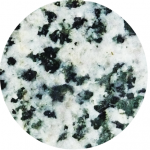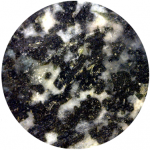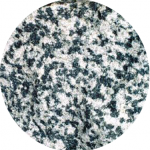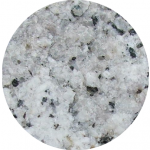4.2 Classification of Igneous Rocks
Igneous rocks are classified into four categories: felsic, intermediate, mafic, and ultramafic, based on either their chemistry or their mineral composition. The diagram in Figure 4.2.1 can be used to help classify igneous rocks by their mineral composition. An important feature to note on this diagram is the red line separating the non-ferromagnesian silicates in the lower left (K-feldspar, quartz, and plagioclase feldspar) from the ferromagnesian silicates in the upper right (biotite, amphibole, pyroxene, and olivine). In classifying intrusive igneous rocks, the first thing to consider is the percentage of ferromagnesian silicates. In most igneous rocks the ferromagnesian silicate minerals are clearly darker than the others, but it is still quite difficult to estimate the proportions of minerals in a rock.
Based on the position of the red line in Figure 4.2.1, it is evident that felsic rocks can have between 1% and 20% ferromagnesian silicates (the red line intersects the left side of the felsic zone 1% of the distance from the top of the diagram, and it intersects the right side of the felsic zone 20% of the distance from the top). Intermediate rocks have between 20% and 50% ferromagnesian silicates, and mafic rocks have 50% to 100% ferromagnesian silicates. To be more specific, felsic rocks typically have biotite and/or amphibole; intermediate rocks have amphibole and, in some cases, pyroxene; and mafic rocks have pyroxene and, in some cases, olivine.
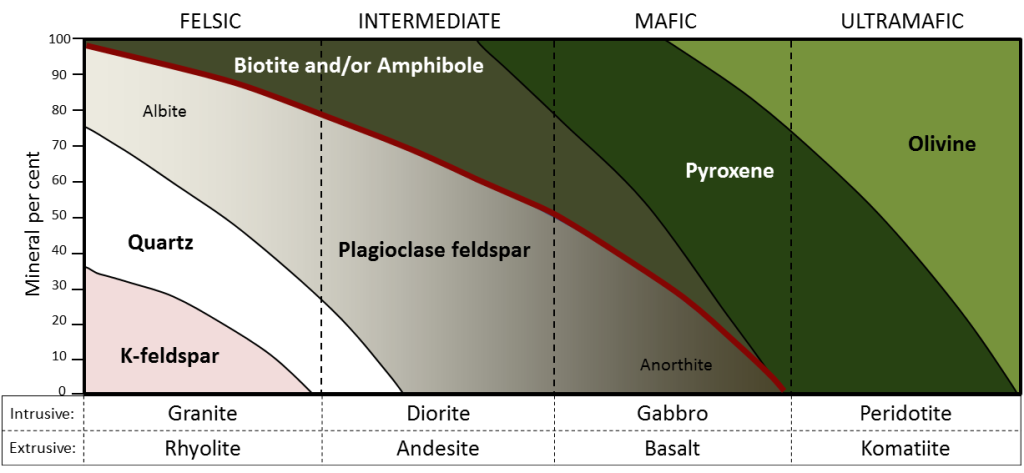
If we focus on the non-ferromagnesian silicates, it is evident that felsic rocks can have from 0% to 35% K-feldspar, from 25% to 35% quartz (the vertical thickness of the quartz field varies from 25% to 35%), and from 25% to 50% plagioclase (and that plagioclase will be sodium-rich, or albitic). Intermediate rocks can have up to 25% quartz and 50% to 75% plagioclase. Mafic rocks only have plagioclase (up to 50%), and that plagioclase will be calcium-rich, or anorthitic.
Practice Exercise 4.2 Mineral proportions in igneous rocks

The dashed blue lines (labelled a, b, c, d) in Figure 4.2.2 represent four igneous rocks. Complete the table by estimating the mineral proportions (percent) of the four rocks (to the nearest 10%).
Hint: Rocks b and d are the easiest; start with those.
| Rock | Biotite/amphibole | Pyroxene | Olivine | Plagioclase | Quartz | K-feldspar |
|---|---|---|---|---|---|---|
| a | ||||||
| b | ||||||
| c | ||||||
| d |
Figure 4.2.3 provides a diagrammatic representation of the proportions of dark minerals in light-coloured rocks. You can use that when trying to estimate the ferromagnesian mineral content of actual rocks, and you can get some practice doing that by completing Practice Exercise 4.3. Be warned! Geology students almost universally over-estimate the proportion of dark minerals.

Practice Exercise 4.3 Proportions of ferromagnesian silicates
Igneous rocks are also classified according to their textures. Almost all intrusive igneous rocks are phaneritic (from the Greek word phaneros meaning visible), meaning that they have crystals that are large enough to see with the naked eye. Typically that means they are larger than about 0.5 millitmeres (mm) — the thickness of a strong line made with a ballpoint pen. The intrusive rocks shown in Practice Exercise 4.3 are phaneritic. If the crystals are too small to distinguish, which is typical of most extrusive (volcanic) rocks, we use the term aphanitic (from the Greek word aphanos – unseen). Although the individual crystals in an aphanitic rock cannot be observed with the naked eye, they still influence the physical properties of the rock, specifically its colour. In an aphanitic rock, the colour of the groundmass, as seen on a fresh non-weathered surface, can provide clues about its mineral composition. Mafic rocks (basalt) tend to be dark black to grey in colour, intermediate rocks (andesite) tend to be a lighter grey, and felsic rocks (rhyolite) tend to be pale grey, white, cream or pale pink in colour.
In general, the size of crystals is proportional to the rate of cooling. The longer it takes for a body of magma to cool, the larger the crystals can grow. As already described, if an igneous rock goes through a two-stage cooling process, its texture will be porphyritic.
Igneous rocks that form when lava cools so rapidly that few, if any, crystals form, are often glassy. Two common glassy rocks formed rapid cooling (or quenching) of lava are pumice and obsidian. Pumice is typically light in colour owing to its felsic composition, and is distinguished by its frothy glassy texture and low density. Obsidian is distinguished by its vitreous lustre and pronounced conchoidal fracture. Although obsidian is typically black to dark brown in colour, it is actually felsic in composition.
One final textural term for igneous rocks is vesicular. The vesicles in vesicular rocks form when gasses exsolve from the magma as it rises toward the surface of the Earth. When magma is deep beneath the surface and under high pressure from the surrounding rocks, the gases remain dissolved in the magma, much like the dissolved CO2 gas in an unopened bottle of pop. As magma approaches the surface, the pressure exerted on it decreases, and gas bubbles start to form, much like once a bottle of pop has been opened. The more gas there is in the magma, the more bubbles form. If the magma is runny enough, the gases will rise up through it and escape to surface. In some cases, however, the bubbles of gas are “frozen” in the lava as it cools and form vesicles as it crystallizes into solid rock at the surface.
Names of igneous rocks, based on both composition and texture as described above, can be enhanced by adding using terms like vesicular or porphyritic as modifiers. For example, an andesite that contains hornblende and plagioclase phenocrysts would be described as a hornblende plagioclase porphyritic andesite. A basalt that contains olivine phenocrysts and vesicles would be called an olivine porphyritic vesicular basalt.
Image Descriptions
| Igneous Rocks | Felsic | Intermediate | Mafic | Ultramafic |
|---|---|---|---|---|
| K-feldspar | 0 to 35% | 0% | 0% | 0% |
| Quartz | 25 to 35% | 0 to 25% | 0% | 0% |
| Plagioclase feldspar | 25 to 50% | 50 to 70% | 0 to 50% | 0% |
| Biotite and/or Amphibole | 0 to 20% | 20 to 40% | 0 to 30% | 0% |
| Pyroxene | 0% | 0 to 20% | 20 to 75% | 0% to 75% |
| Olivine | 0% | 0% | 0 to 25 % | 25% to 100% |
| Intrusive | Granite | Diorite | Gabbro | Peridotite |
| Extrusive | Rhyolite | Andesite | Basalt | Komatiite |
Media Attributions
- Figure 4.2.1, 4.2.2, 4.2.3: © Steven Earle. CC-BY-4.0.

